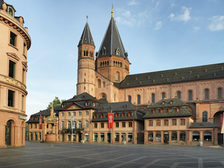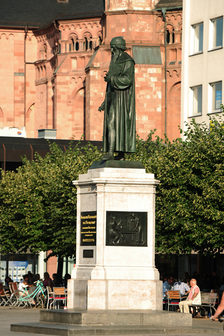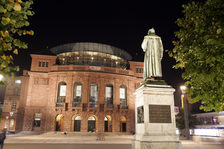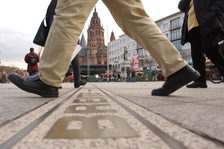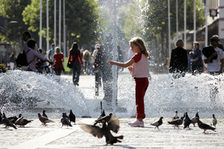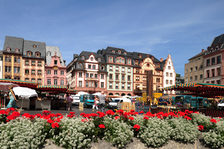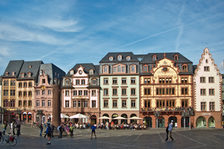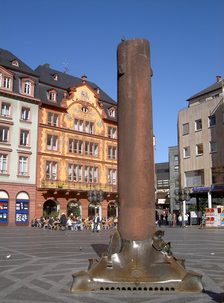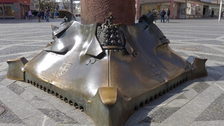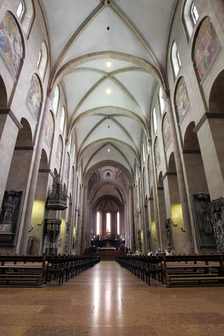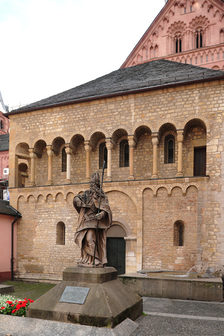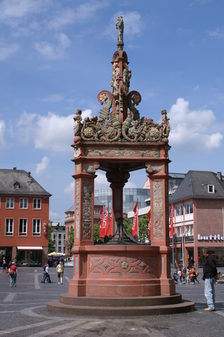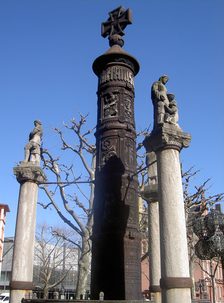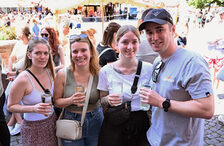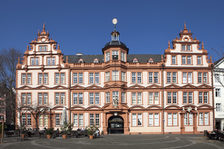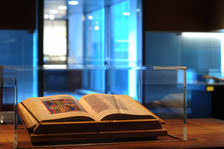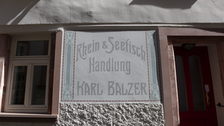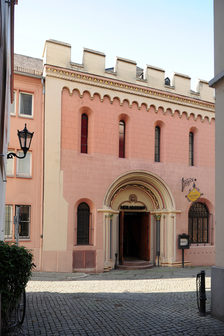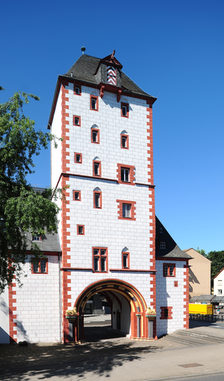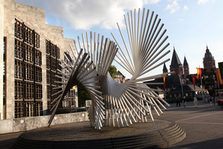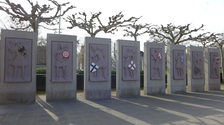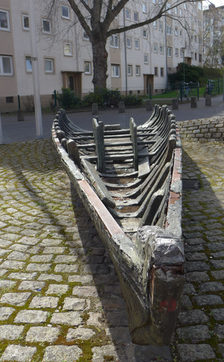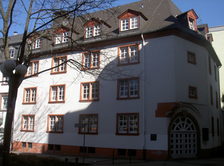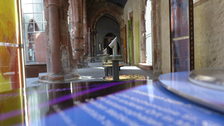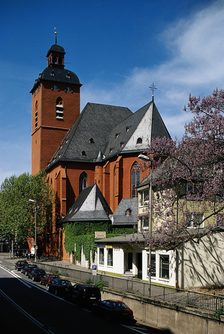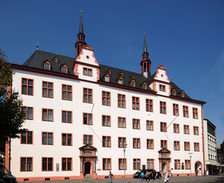City walk: Compact Mainz
Welcome to our virtual city walk
Are you just passing through Mainz or only staying for a little while and want to explore the capital of Rhineland Palatinate on your own and on foot? This virtual city walk will assist you with your historical journey through time.
The selected route takes you on a short and direct route to Mainz's most famous attractions. Be captivated by the 2,000 year old city's eventful history - and be convinced that another visit is worthwhile!
Route information
Suitable for
everyone who only has a little time to explore Mainz.
Accessibility
is ensured. Please use one of the lifts from Rathausplateau into the underground garage level U1. Keep right at the garage exit, then you will be able to follow the course of the walk.
Duration
approx. 1 hour
Route
City walk
1. Gutenbergplatz − Gutenberg Monument − Theatre
Gutenberg Monument
Your tour begins at Gutenbergplatz. The city's most famous son is enthroned on the life-size statue in the square that bears his name. Danish sculptor Berthel Thorvaldsen provided the design for the bronze statue of Johannes Gutenberg. The monument shows the inventor of the printing press, of whom there is no contemporary portrait, in an idealised depiction: bearded, elegantly dressed, with Bible and print types in his hand. The reliefs in the plinth represent the invention and practice of the art of book printing.
Mainz State Theatre
The great hall of the Staatstheater Mainz (Mainz State Theatre), in the historical building designed by Moller, is located opposite. At the time of its construction from 1829 to 1833, it was considered a new creation. For the first time, Georg Moller, one of the most important architects of his time, used the curve of the auditorium for the external design and by doing so revolutionised theatre construction at the time.
50th line of latitude
Before we move on to the next stop, take a look down: The route of the 50th line of latitude is embedded in the ground directly at your feet, running across Gutenbergplatz and Ludwigsstraße.
Interactive route
2. Höfchen − Market Square
Höfchen
Now, if you turn right in an easterly direction, you will come across the Höfchen, the first of the three cathedral squares. The square bears this name because the residence of the archbishop stood here until the 15th century. Originally, the square was almost completely separated from the market which is still indicated today by the commercial buildings. At warm times of the year, the benches provide a welcome break around the Höfchen fountain. The fountain is covered during the Christmas market. In its place, the brightly-lit pyramid with figures from Mainz offers a sparkle to your eyes.
Market square
Wander straight on towards the Marktplatz (market square), the heart of city life. If you visit on a Tuesday, Friday or Saturday, come before 2 pm to enjoy one of Germany's most beautiful weekly markets.
There the Tourist Information (mainz STORE) is located, where you can also buy a lot of Mainz souvenirs.
The opening times are
Monday to Saturday: 10 a.m. to 6 p.m.
Sunday (Jan-Oct): 11 a.m. - 4 p.m.
Market buildings
Whether a market day or not - the square is surrounded with market buildings to the left and cathedral buildings to the right. Market buildings 11-15 were reconstructed after being destroyed in the Second World War. The demolition and redevelopment was done in 2008 to once again restore the medieval appearance of the façade. The internationally renowned Italian architect, Massimiliano Fuksas, created today's combination of historical façades on the market and the modern architecture behind in the direction of Korbgasse.
Heunensäule
Now take a look towards the middle of the market square. The Heunensäule column has stood here since the cathedral's 1,000 year anniversary in 1975. With its bronze coating, the Heunensäule recounts many stories from the city's history.
For example, turn you attention to the head piece on all four corners: The helmet of a Roman legionnaire recounts the city's foundation in 13 BC. The bishop's mitre refers to the rich ecclesiastic tradition. The fool's cap is symbolic of a Phrygian cap worn by French revolutionaries.
The Imperial Crown of the Holy Roman Empire stands for the numerous chapters of the empire's history written by kings and emperors who found themselves time and time again in Mainz, one of the powerful centres of the Roman Empire. A few were even crowned here.
Interactive route
3. St. Martin's Cathedral
We continue to St. Martin's cathedral (Dom St. Martin) which rises above the market square. The Baroque cathedral buildings originate from Johann Valentin Thomann and survived the war almost intact.
St. Martin's Cathedral
Enter through the Marktportal gate. The cathedral was built in 975 under Archbishop Willigis and has experienced plenty of fires, destruction and rebuilding over the course of many centuries. The archbishops of Mainz, who were also archchancellors and the most powerful prince-electors in the empire, wanted the size of the cathedral to express their power in the church and politics. Mainz cathedral is a monument of the empire's history as the coronation site of German kings.
St. Gotthard's Chapel
Particularly noteworthy, in addition to the interior of the cathedral, with the graves of the archbishops, are the Romanesque St. Gotthardkapelle (St. Gotthard's Chapel), located at the side of the market, made from concha limestone, and the late-Gothic cloister. Today, the Cathedral and Diocese Museum is located in the chapter houses and in the cloister. If you take the time, you can admire works of art from many centuries of church history in Mainz.
Interactive route
4. Market Fountain − Liebfrauenplatz − Gutenberg Museum
Market fountain
If you leave the cathedral, turn right and you will come to the outermost corner of the market square to the Marktbrunnen (market fountain). Mainz archbishop, Cardinal Albrecht von Brandenburg, donated the strikingly impressive sandstone fountain to his citizens in 1526, which today is not just the oldest, but also the most beautiful Renaissance fountain in Germany. However, the market fountain is not just artistic, it is also a significant historical symbol of the balance of power. In a time where there was no central water supply and public fountains with good quality water were rare, the archbishop's donation initially seems generous. Look closer and in the imagery you will clearly recognise political-didactic elements. The iconography recollects the peasant revolts which were also bloodily beaten down in Mainz.
Nagelsäule column
Just a couple of steps away there is another past story waiting for you. To the right of the cathedral, in the direction of the east choir, is the Nagelsäule column. It is the result of a large fundraising campaign during the First World War. Each donor was allowed to drive a nail into the Nagelsäule column. The nails could be acquired in different styles and cost between one and 20 Reichsmarks. 170,000 Reichsmarks were collected in this way for social institutions.
There are three other columns grouped around the Nagelsäule column which show allegorical figures of unity, power and charity. The collection of columns was elaborately renovated in 2006 and has been located on its original site since 2011.
Liebfrauenplatz
Continuing straight on you will come to Liebfrauenplatz, the largest of the three cathedral squares. The square is named after the Liebfrauenkirche church which stood in front of the cathedral's east apse until its destruction in 1793 and its ensuing demolition. A construction made of sandstone from the ground now stands where its walls once were.
If today happens to be a Saturday between mid-March/April, don't miss out on a trip to the "Mainzer Marktfrühstück" (Mainz Market Breakfast). It takes place here, exactly on this square - just follow the crowds. You can enjoy the native wine directly from the producer at the Mainz wine maker's stand.
Palais of the roman emperor and Gutenberg-Museum
The late renaissance palace, Zum Römischen Kaiser (Palace of the Holy Roman Emperor), is located to the north o the square. Built in 1653 after the Thirty Years' War as the first and wealthiest community hall, the building had an epochal influence on building activity in Mainz. Mozart played here (1736). Voltaire (1753) and Goethe (1814) came here.
Since 1962, the Gutenberg Museum has been located in this palace and in an adjoining new building. A visit to this globally recognised museum of scripture and printing art is definitely worth it. It shows how Gutenberg printed and how he developed his world-changing invention. You can, of course, also see the world-famous 42 line Bible and the world's first printed books.
Interactive route
5. Fischergasse − Heilig-Geist − Iron Tower
Fischergasse
At the Baroque palace, keep walking forward on Salmengässchen through the gateway. Now keep to the left and turn into the narrow Fischergasse. Its name comes from the Rhine fishermen once based here. Fish markets characterised the street's business which is verified by a few company inscriptions.
The Fischergasse is typical of old Mainz. The city wall passed through here. Former city wall walkways are even integrated into the houses.
Heilig-Geist-Spital
Straight ahead you will discover red sandstone walls, behind which the past still noticeably appears: The Heilig-Geist-Spital (holy spirit), Germany's oldest public hospital. When it was built in 1236, it served as housing for pilgrims, the poor, the old and the ill.
Throughout the years, Heilig-Geist has been used for very different purposes. Locals and tourists alike will appreciate the unique charm of the time-honoured building with its impressive arches. Today it houses a culinary establishment.
Eisenturm
Carry on to the Eisenturm (iron tower). Leave the Heilig-Geist on your right and keep going straight ahead. Next to the Alexanderturm tower and the Holzturm (wooden) tower is the Eisenturm, built around 1240, a contemporary witness to the medieval city fortification. The six-storey tower received its name from the iron market once held on the banks of the Rhine. From the gate tower, to a military prison through to a location for art exhibitions, the Eisenturm's uses have changed through the centuries.
Today, the art association Eisenturm Mainz e.V. founded in 1975 allows you to take in the history of the tower and at the same time enjoy contemporary art. Exhibitions are shown in the tower's rooms. Find information on current exhibitions and opening hours on the art association Eisenturm’s website (www.kunstverein-eisenturm-mainz.de).
Interactive route
6. Town hall – Rhine Waterfront
Town hall
If you go back a little along Rheinstraße, you can use the narrow steps or conveniently use the steps next to the bridge tower. Now cross the wide footbridge over Rheinstraße. You will then come out directly at Jockel-Fuchs-Platz, named after Mainz's lord mayor, Jakob "Jockel" Fuchs (1919 - 2002).
Straight ahead you will come across the new Rathaus (town hall), which was designed by Danish architects Arne Jacobsen and Otto Weitling and built between 1970 and 1973. If you carry on following the square's course, you will be going in the direction of the Rhine. Use the opportunity to enjoy a view of "Father" Rhine and the Main mouth from the platform. You will then reach the waterfront directly below via the wide steps.
Kurfürsten-gallery
The tour now carries on along the Rhine waterfront, past the Rheingoldhalle hall (seat of mainzplus CITYMARKETING GmbH) in the direction of the Theodor Heuss bridge. Behind the HILTON Hotel, you will see the copy of the sandstone relief behind a fountain, with the seven prince-electors and the German king. The original can be found in the Mainz State Museum at Große Bleiche. Go back a little and leave the Rhine waterfront.
Replica of a Roman ship
You can cross Rheinstraße at the traffic lights. Turn left on Karmeliterstraße onto Löhrstraße. You will see the replica of a Roman ship in front of the new Hilton Hotel building. The remains were found during construction works. The original and two reconstructed ships, as well as numerous models, can be found in the Museum of Ancient Seafaring.
Interactive route
7. Algesheimer Hof − St. Christoph
Algesheimer Hof
Now turn left and follow Hintere Christofsgasse. Where this becomes narrower is where the former Algesheimer Hof stands, where Gutenberg lived until his death.
St. Christoph
In front of us, we now see the ruins of the early Gothic church, St. Christoph's. It was built between 1292 and 1325. Destroyed in the Second World War, the church was renovated as a cenotaph and memorial site. Light and glass provide a contrast to the ruins since the remodelling. Twelve brightly coloured glass slabs reflect the key points in Mainz's history.
The redesigned memorial site was presented to the public on 27 February 2015 in memory of the destruction of the city of Mainz 70 years ago. St. Christoph's is also important as Gutenberg's parish.
8. St. Quintin − Old university
St. Quintin
Now, if you continue on Hintere Christofsgasse, you will come to Schusterstraße. Turn left and walk forward to the intersection. Towering on the corner is probably the oldest parish church in the city, St. Quintin's, enclosed between the house fronts. It was first mentioned in 815 and built from 1288 in a Gothic style. It was rebuilt after being destroyed in 1942, and the church was completely renovated up to 1996. Unfortunately, it is only open at church service times.
Old university
Now cross the intersection and follow Schöfferstraße. On the right side lies the Alte Universität (old university) "Domus Universitatis." It was constructed from 1615 to 1618 by the Jesuit order under prince-elector Johann Schweikardt von Kronberg. The building originally housed the Faculty of Philosophy and Theology and the Jesuit school. The old university is still a building for scientific institutions. The Franciscan church where Gutenberg was buried in 1468 stood close by until 1742.
Done!
You have now arrived close to the starting point. Gutenbergplatz is located on the right behind the bus stop. If you still have time, it’s best to go straight on in the direction of Augustinerstraße. Lots of small shops, cafés, restaurants and wine bars in the picturesque street invite you to take a stroll and have a break.
Interactive route
More informations ...
can be found on the "Historical Mainz" slabs in front of the attractions and on mainz.de.


